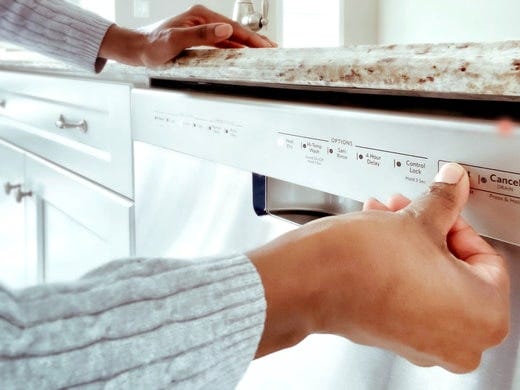
Dishwasher programs & cycles
Ever wondered what all those buttons on your dishwasher actually do? Find out what dishwasher settings and cycles you should be using with every wash, thanks to Finish®.

From drying and sanitizing to even "quiet" mode, your dishwasher likely has a variety of settings that do a range of different things (some of which you might not even know about!). Although we tend to get into a habit of using the same dishwasher setting, it’s important to understand what your machine is capable of to ensure you’re getting the most out of your model.
Read on for more information on some of the standard dishwasher settings and cycles you might find on a modern dishwasher.
Dishwasher eco setting
"Eco-mode", or the energy saving setting on a dishwasher, helps to lower the wash and rinse temperatures during a cycle, in turn using less energy that would have otherwise been used to heat the water.
But does using the dishwasher eco setting sacrifice the quality of your clean? Some believe that due to the lower water temperature, you shouldn’t expect a quality result – however, if your dishes are small and not heavily soiled, the eco setting should work just as well as any other setting. Plus, you could save yourself money (and help the environment!) in the process. Just take note: eco cycles usually take longer than regular cycles.
Dishwasher drying setting
There’s nothing worse than opening your machine after a cycle and your dishes are still dripping wet. Thankfully, it’s common for modern dishwashers to include multiple drying settings, too.
Air dry
Mainly found in newer models, the air dry setting makes your dishwasher door open automatically after a cycle to allow the steam to escape.
Heated rinse
Also more commonly found in modern dishwashers, the heated rinse setting increases the water temperature towards the end of the cycle. When it’s done, the inside of the machine attracts the heat, pulling the moisture away from the dishes.
Fan dry
In your bid to save as much energy as possible (and cut down your monthly electricity bill!), opt for the fan dry setting on your machine. In doing so, your machine will use circulated room temperature air to dry your dishes, as opposed to running its internal, energy-zapping heater.
Heat dry
Just as it sounds, the heat dry setting on your dishwasher uses an internal exhaust fan to dry your dishes with heated air. Although this setting is handy to use if you’re going to be out of the house for a considerable time after the dishwasher cycle stops, it’s best to either use the air dry or fan dry settings, or even crack the door open to let the dishes dry naturally.
Dishwasher cycles
You might think that choosing a ‘normal’ cycle is the best way to go for your everyday dishes, but perhaps try using some of the other cycles available on your dishwasher for a better clean.
Most conventional dishwashers come with three standard cycles; light, normal and heavy for your larger pots and pans. These settings are well suited to regular dishes and everyday dirt – but you might find your model has some of the below dishwasher cleaning cycles, too.
Auto
Similarly to the eco setting, the auto cycle uses a sensor to detect how much dirt is on your dishes, and then adjusts the water temperature and cycle duration to suit accordingly.
Express
The express, or ‘speedy’ cycle, can have your dishes sparkling in as little as 20 minutes – but be aware, this setting is only recommended for lightly soiled dishes that simply need a quick clean.
Quiet
Commonly found in premium dishwashers, ‘quiet mode’ or the silent cycle claims to reduce the noise made while your machine is on. Perfect for open plan homes (or sleeping babies!).
China/Crystal/Glassware
This cycle will help to protect your more delicate items (such as glassware, china and crystal) by using a lower temperature. Of course, avoid putting extra special items in the dishwasher where possible.
Rinse only
Even though this cycle may sound counterintuitive (remember: you shouldn’t rinse your dishes before putting them in the dishwasher!), it’s actually a handy way to ensure you don’t end up with a smelly dishwasher. The rinse cycle uses no detergent and very little water and power to splash your dishes as they sit in the machine, waiting for a wash cycle. This means you can hold off until you have a full load to run your dishwasher, without the hassle of letting your dishes fester in the machine.
Delay start
Need to run your machine but won’t be home to turn it on? The ‘delay start’ setting enables you to set a timer that will activate a pre-selected cycle. This option is particularly handy when choosing to wash your dishes at night, when your electricity plan is often cheaper.
.png?width=70&height=45&format=png&quality=50)